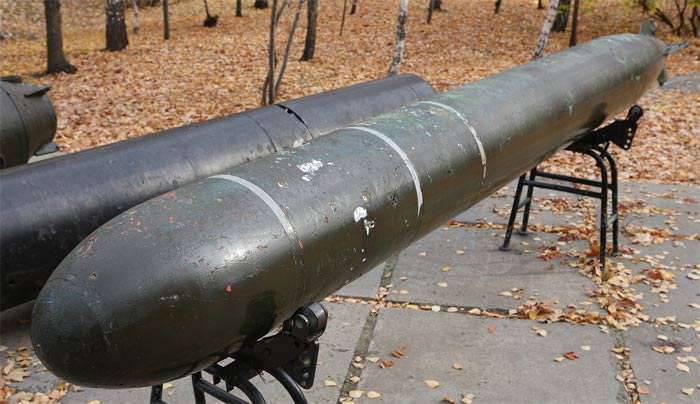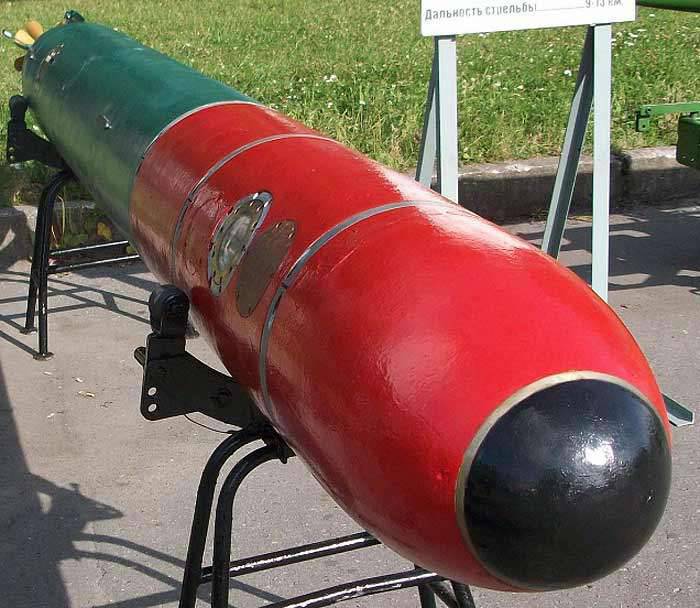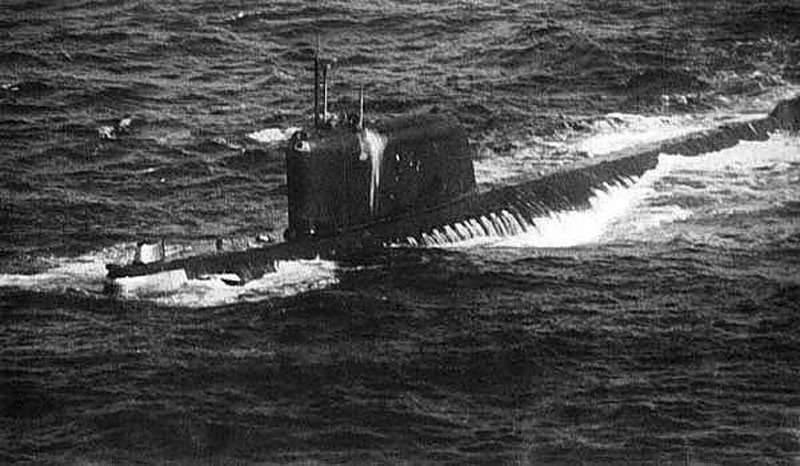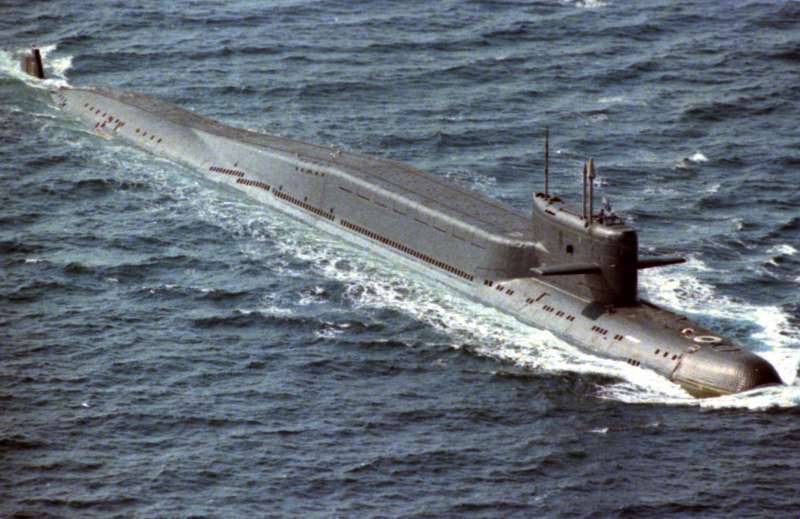Torpedo MGT-1
Theoretical calculations showed that a significant decrease in the dimensions of the torpedo in comparison with the existing weapons In general, it will not prevent her from successfully solving her tasks. In addition, the production of homing systems was already mastered, which made it possible to further increase the effectiveness of the use of torpedoes. Thus, a promising submarine could easily use self-guided torpedoes of the caliber 40, see self-defense. However, such a weapon did not exist until a certain time and should be developed.
The project to create the first Russian compact torpedo started in the late fifties at the Scientific Research Institute-400 (now the Central Research Institute Gidropribor). Chief Designer appointed L.N. Akatova. The project received the symbol "239 product". The aim of the project was to create a promising electric homing torpedo of the smallest possible dimensions, intended for use with new 40-cm torpedo tubes. Due to the lack of significant developments in this area, the authors of the project had to create most of the units from scratch. As a result, the new torpedo turned out to be quite progressive in terms of design, but this had a negative impact on some aspects of testing and operation.

Torpedo MGT-1. Photo Militaryrussia.ru
Due to the lack of a certain experience, which appeared later, the body of the "Products 239" was performed according to the traditional scheme. It was a cylindrical unit with a hemispherical head fairing and a tapered tapered tail. Behind on the body were four stabilizer feathers, on which the steering wheels were mounted. At the tail end of the hull, two coaxial propeller shafts were removed. An interesting feature of the hull of the new torpedo was the materials used. To facilitate the design while maintaining the required strength, the casing was made of aluminum-magnesium alloys. In the future, such materials are widely used in torpedo building.
The layout of the 239 Product was traditional for self-guided torpedoes with an electrical propulsion system. In the head part of the hull a charging compartment with a large volume was planned for placement of a hydroacoustic guidance system. Behind the charge was placed the battery compartment, and the hull feed was given under the control systems, steering cars and the engine. Due to the dense layout of the units and their compact dimensions, all the necessary devices could be placed in a housing with a diameter of 400 mm and a length of 4,5 m. The weight of the “239 Products” was 750 kg (according to other data, 510 kg).
In the head of the case, under a light fairing, placed antenna hydroacoustic guidance system. "The product 239" was one of the first Soviet torpedoes with a combination of active and passive guidance system. According to available data, the passive part of the equipment was built on the basis of the SAET torpedoes aggregates and was based on German developments on the G7es product. Such a guidance system had an antenna with four vertical receivers, with the help of which it had to determine the direction to the target in azimuth.
In addition, a new active guidance system, developed under the direction of B.V. Kiseleva. This device was supposed to emit signals and receive reflected oscillations, thereby finding a target. Due to the use of two search systems for different types of targets, it was proposed to increase the probability of detecting an enemy ship and, consequently, increase the chances of hitting it. Since the promising torpedo was supposed to be used against surface ships, guidance systems had to search for targets only in one plane, which to some extent simplified their design.
The torpedo "Product 239" received a fighting compartment with 80 kg of explosive. In the upper part of the hull, a throat was provided for installing a proximity fuse that reacted to the magnetic field of the target ship. According to other sources, an acoustic target sensor was used. This device was created under the direction of LS. Erokhin. In addition to the main proximity fuze, a self-liquidator was envisaged, designed to undermine the torpedo in the event of a battery charge after a slip.
The project also developed a practical charging unit for use in exercises. It differed from a full-fledged combat by the absence of an explosive charge and the presence of some other devices, as well as the corresponding ballast. An interesting feature of the practical “239 Product” was the presence of a so-called. rocket device. Moving toward the training target, the practical torpedo was supposed to shoot off signal flares, which made it possible to track its movements. To simplify the search for practical torpedoes after firing, a light signal and a mechanical noise generator or “snitch” were also proposed.

Torpedo in a different color. Photo Militaryrussia.ru
The central part of the case was allocated for the installation of a silver-zinc rechargeable battery "Item 518-1U". It was a disposable battery that did not have the ability to recharge. The storage life of the battery was brought to 8 years, helped by placing the electrolyte separately from the cathode and the anode. This liquid should be stored in a separate ampoule tank and fed into the batteries only at the moment of the shot. Compressed air pumped into a titanium tank was used to displace electrolyte from the ampoule. After supplying the electrolyte, the battery could produce the required voltage and power.
In the stern "Products 239" placed a DC electric motor type DP-11М, built according to the traditional for torpedoes bi-reactive scheme. Its design provided for a rotating rotor and stator connected to two propeller shafts. This made it possible to remove the reducer, differential or other additional equipment from the design of the power plant, which leads to complication and weighting of the torpedoes, as well as negatively affecting the secrecy of movement.
The 239 project was notable for its great novelty and widespread use of new ideas. In this context, the control system, in the composition of which they introduced several new non-standard devices, was no exception. Under the leadership of the chief designer V.V. Seleznev at NII-40 created a new set of electromechanical and hydraulic control devices. A heading device with pneumatic start and electrical maintenance, a pendulum type leveling device, as well as a depth gauge with hydrostatic and maneuvering blocks, which were previously installed at a certain depth of the course, were proposed. The data from these devices, as well as from the guidance systems, were processed by electromechanical automatics and transformed into commands for electro-hydraulic steering gears. Thus, the torpedo could move both in a straight trajectory before the target was detected, and to maneuver when approaching it.
The engine used could accelerate a comparatively light torpedo at speeds of the order of the 28-32 node, which was related to its power and the noise produced during operation that interfered with the homing systems. Because of the small dimensions of the hull, the torpedo's battery did not differ in high capacity, which affected the maximum range of the course - up to 6 km. The depth machine could withstand the product at a distance of up to 10 m from the surface. In addition, he provided the output of a torpedo to a predetermined depth both when firing from the surface and when diving.
The design work was completed in the 1960 year, after which several prototypes were used that were used in the tests. The first checks of the “239 Products” were carried out at the existing sighting stations. In addition, the latest tests were carried out on the latest submarines, which in the near future were to master new weapons for self-defense.

The 45 K-659 submarine of the 1 project is the first MGT-XNUMX carrier. Photo Rvvdku-vi.ru
In November 1960, the K-45 nuclear submarine, the lead ship of project 659, entered the state tests. Until mid-summer of next year, the submarine intended for the Pacific fleetpassed various checks. Among other things, in 1961, the fleet and industry tested a new 400 mm caliber torpedo. According to reports, during the tests, the new torpedo faced a lot of problems, and also showed some of the shortcomings of its design.
The test run of the 239 Product on the K-45 submarine, conducted in the Pacific Fleet, is colorfully described in the memoirs of designer R.А. Gusev "This is the torpedo life." Due to various flaws, problems were manifested both on the shore and after loading onto the submarine carrier. For example, before loading onto a boat, the torpedo needed to be checked for tightness. An experimental product was filled with air and placed in a special pool. After this, the testers were able to observe how air was released from all the joints, holes and hatches in the form of a mass of bubbles. It turned out that the torpedo not without problems moved the long road to the Pacific bases. Attempts to seal the product were also associated with certain problems. The specialists did not have the required set of keys, and the tool for other torpedoes was not fully suitable for servicing the 239 Product. Nevertheless, with the help of available tools and ingenuity, testers managed to bring the torpedo into the desired state.
Soon, an experienced torpedo was sent to the K-45, where a new phase of inspections began. A few days later, design flaws reappeared. During the so-called pulling through the torpedo tube, the product is jammed. It is stuck in the area of the starting block and the active hammer hook. To extract the torpedo, it was necessary to disassemble several devices of the torpedo tube. Only after that it became possible to study the prerequisites for such a malfunction. During the inspection of the units of the torpedo and the apparatus, it was found that different types of weapons have a different stop angle of the trigger, which can lead to some problems. In addition, it turned out that during the assembly of the experienced "239 Product", a certain rationalizer replaced the brass trigger with a titanium trigger. Thus, the titanium trigger entered into interaction with the titanium hook, which led to the complete jamming and stopping of the torpedo inside the apparatus. Soon these shortcomings were eliminated, but this work took time.
After that two practical torpedoes were delivered to the Far East for experienced firing. Both launches were unsuccessful: the acoustics for several seconds recorded the noise of the screws, after which the torpedoes disappeared. There were several versions concerning the reasons for such behavior of new torpedoes, but it was impossible to confirm or deny them because of the loss of experimental products. After lengthy disputes, it was decided to hold two control shots. One should be done at a shallow depth and at the maximum speed of the submarine carrier, the second at a great depth and low speed. Such an approach made it possible to establish the causes of previous accidents, as well as find out why shots end in failure: because of a torpedo or because of torpedo tubes. In the future, two control shots justified themselves and allowed to gather the necessary information.
According to the results of testing 1960, the torpedo "Product 239" was adopted by the Soviet Navy. The corresponding order was issued in 1961. The weapon received the official designation MTG-1. The serial production of torpedoes was entrusted to the Dagdizel plant (Kaspiysk). New torpedo armed submarines of various types, equipped with 400-mm torpedo tubes. Thus, during testing, the submarine of the 659 project was used for testing, and later MTG-1 was introduced into the range of weapons of other submarines. These were boats of the 658 and 658М, 670А, 675 and early versions of the 667 project. The last project that involved self-defense with 400-mm torpedoes was the Kalmar 667BDR. Several submarines of this type still serve.
Submarines of different projects differed in the configuration of torpedo tubes. For example, the submarines of the 659 project had four 533 caliber mm nasal vehicles (torpedoes 4 ammunition - one per vehicle), and were also equipped with two nose and two fodder 400-mm vehicles. At the same time the boat carried to 18 small torpedoes. The Kalmar submarines, in turn, had only nose torpedo tubes: four 533 mm caliber and two 400 mm caliber. Also of interest is the configuration of torpedo tubes, provided for in the 675 project. Such boats carried four bow 53-cm apparatus and two stern 40-cm with 16 ammunition and 4 torpedoes, respectively.
Despite the relatively wide distribution and a large number of carriers, MGT-1 torpedoes until a certain time were a big problem for submariners and designers. Part of the design flaws was revealed only after the product was adopted for service. All this required additional work, new tests, etc. In addition, the refinement after the start of operation had a negative impact on the combat capabilities of submarines carrying combat duty.
However, all efforts were not wasted. The work resulted in full compliance with customer requirements and ensuring high reliability of both individual units and the entire torpedo as a whole. Due to this, the fleet received a modern weapon with sufficiently high characteristics, suitable for solving the basis of the task - the self-defense of submarines when meeting with enemy anti-submarine ships.
At the same time, torpedo builders gained valuable experience in constructing new weapons for the submarine fleet. Were identified the basic requirements for advanced weapons, which allowed to achieve high performance. Thus, it was found that fodder torpedo tubes do not ensure the proper effectiveness of a torpedo attack when moving at high speed. In addition, for firing at high speeds, a torpedo of appropriate design with a solid hull of correct lines was required. Similar requirements should be placed on torpedoes intended for firing from great depths. Also for use with depth it was necessary to reduce the number of hatches, technological holes and other potential causes of leakage. Finally, it was necessary to significantly update the composition of the onboard equipment of the torpedoes, since some of the “traditional” devices were already outdated and did not meet the requirements of the time.
The goal of the 239 / MGT-1 project was to create the first domestic torpedo of a new class. As is always the case with new developments, the project encountered some problems that were manifested both during the tests and after the start of operation by the fleet. Nevertheless, the long-term refinement of the product led to the desired results and allowed the new submarines to provide effective weapons for self-defense. According to various sources, the torpedoes of the MGT-1 were in service until the early eighties, after which they were replaced by newer weapons with enhanced characteristics.
The MGT-1 project allowed the submarines to be armed with new torpedoes, as well as gaining important experience for the creation of new such weapons. However, after a few decades, all this knowledge has lost its value. Some time ago it was decided to use only 533-mm torpedo tubes on submarines. All new submarines receive only such weapons, and systems of other calibers are available only on relatively old ships. Thus, new small-sized torpedoes, developing the product concept of MGT-1, are no longer being developed, although the operation of existing systems continues.
Based on:
http://deepstorm.ru/
http://rusunderwater.ru/
http://militaryrussia.ru/blog/topic-466.html
Shirokorad A.B. Weapons of the domestic fleet. 1945-2000. - Minsk: “Harvest”, 2001
Gusev R.A. Such is the torpedo life. - S.-PB.: Willow, 2003

Information